 |
surfresearch.com.au
the catalogue #339 |
| home | catalogue | history | references | appendix |
|
| 1975 Ron Wade Molded Spoon Knee Board 4 ft 10" |
#339
|
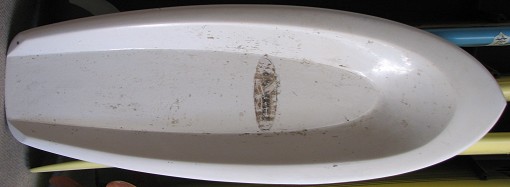
|
Length
:
|
4
|
ft |
10
|
inches | L2: | |
|
Width
:
|
20
|
inches |
Wide
Point :
|
+4
|
inches | |
|
Nose
:
|
17
1/4
|
inches |
Tail
:
|
17
1/4
|
inches | |
|
Thickness
:
|
2
3/4
|
inches |
Pod
:
|
12
|
inches | |
|
Nose
Lift :
|
inches |
Tail
Lift :
|
inches | |||
|
Weight
:
|
kilos |
Volume
:
|
litres | |||
|
Spoon
:
|
2
1/2?
|
inches |
| FIN
9" x 7 1/2 " base x 11'' span @ 4 1/2'' Greenough Stage II The original fin appears to be molded into the bottom but has been replaced with a laminated fin inserted into the original fin's base. |
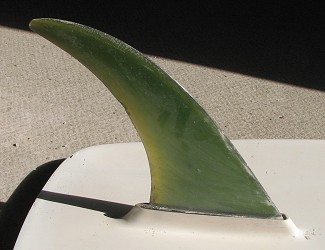 |
| DECOR
DECALS Deck:RON WADE SURF BOARDS 997-5442, black text and script on an adhesive decal at the sweet spot. The decal is scuffed and damaged. Bottom: MARKINGS Deck: Bottom: COLOUR Deck: white pigment gel coat. Bottom: white pigment gel coat. |
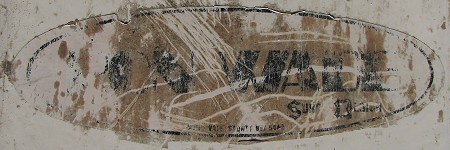 |
MANUFACTURER HISTORY
Ron Wade shaped
for several Brookvale surfboard companies before staring his own label
around 1968 at Mona Vale.
Other Ron Wade
Surfboards
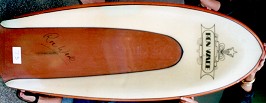
DESIGN HISTORY
Originally based
on a spooned deck balsa wood kneeboard, the Greenough Flex Spoon (Velo
1) was molded off the bottom and then had foam block rails added.
This construction
method was not followed by other manufacturers - a full blank was shaped
with a thin foam base that was removed after laminating the bottom.
First used in Australia
in 1965, George Greenough's performance had a huge impact on many Australian
designers.
The design was given
exposure in the surf media as was George Greenough's surfing and surf photography.
Many manufacturers
made copies of the design and the intensive glassing requirements required
a premium price.
The most recognised
models were produced by at Hayden Surfboards Caloundra Queensland, featuring
Greenough's dramatic Fighter Plane decal, see below.
The design peaked
in popularity around 1970 with the release of George Greenough's The
Innermost Limits of Pure Fun - featuring some his surfing
on Spoon and inflatable mat (see #66)
but most famously included on-board footage of radical performance surfing
and serious tube rides.
Because the high
performance capabilities of the design were only achievable in quality
waves and the low floatation meant that only the most fit riders were able
to catch waves, by 1973 the design was largely supplanted by Peter Crawford's
Slab design, circa 1969, see # 83.
Initially Peter Crawford
simply filled in the spooned deck to greatly increase floatation and expand
the wave range, but over a long life the Slab was apadpted with a range
of rail shapes and fin configerations, see #
58.
In the USA the Fish
was a notable alternative in kneeboard design.
Greenough's extreme
design was attempted to be recreated in stand up boards, most infamously
by Nat Young at Gordon Woods Surfboards in 1965, see The
Nautilas.
Although this board
was a failure, George Greenough's fin design was to have a huge impact
on Australian surfboards and by 1968 almost every fin bore some relationship
to Greenough's high apsect template.
In 1967 Midget Farrelly, Bob McTavish and other shapers in Sydney developed a short deep vee bottomed board that had strong elements of George Greenough's influence, see # 26.
COMMENTS:
REFERENCES
See
Paipo
Catalogue for other Kneeboards
For more on spoons
see www.flexspoon.com
Magazines
Popular
Science magazine
"Far Out Flexible
Surfboard... the wave of the future" by Eric Blum as told to Al Lees
August 1969 pages
92 to 95.
The
Australian Surfer's Journal
''Moving Forward
- A Greenough Scrapbook 1960 - 1970''
Vol.2 No.2
1999 Pages 76-77, 84, 86-87
Film
1.
The Innermost
Limits of Pure Fun
George Greenough 1970
2.Crystal
Voyager David
Elfick 1973.
CONDITION:
6
(fin replacement)
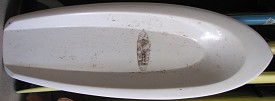
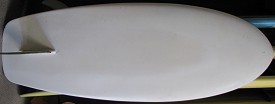
|
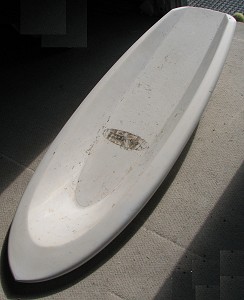 |
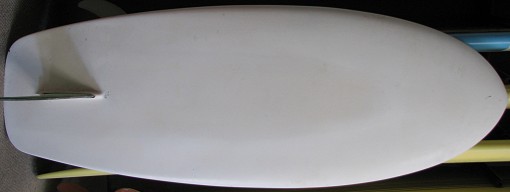

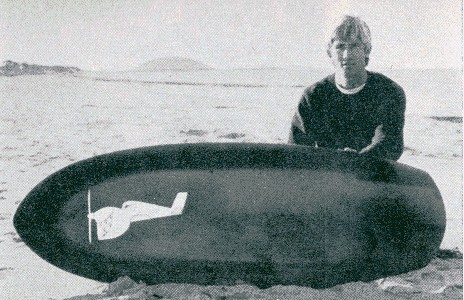 |
Image, right
George Greenough and Spoon Caloundra, Queensland 1966 Photo by Hayden Kenny "Far Out Flexible
Surfboard...
|

| home | catalogue | history | references | appendix |